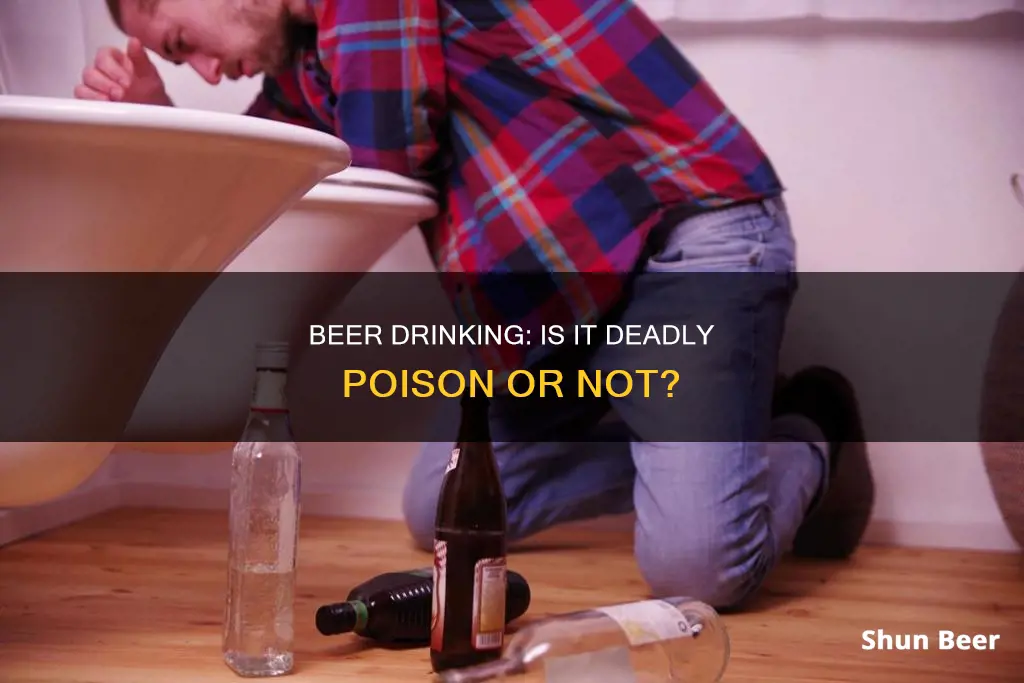
Beer is an alcoholic drink, and as such, it can be harmful and even lethal if consumed in excess. While beer typically has a lower alcohol content than other drinks, excessive consumption can lead to alcohol poisoning, which can be fatal. Additionally, long-term beer drinking can contribute to health issues such as liver disease, heart disease, and certain types of cancer, all of which increase the risk of premature death. It's important to drink responsibly and be aware of the potential dangers associated with alcohol consumption.
| Characteristics | Values |
|---|---|
| Alcohol Content | Beer has one of the lowest alcohol contents of all alcoholic drinks, ranging from 3% to 8% ABV. |
| Lethality | Beer can be lethal if consumed in large quantities in a short period of time, leading to alcohol poisoning. |
| Health Risks | Long-term consumption of beer can lead to liver disease, heart disease, and stroke. |
| Recommended Consumption | The recommended amount is no more than two beers per day for men and no more than one for women. |
| Intoxication | Beer intoxication impairs judgment and coordination, increasing the risk of driving under the influence and making impulsive decisions. |
| Safe Consumption | Drinking in moderation and spacing out drinks can decrease the chances of harmful effects and potential death. |
What You'll Learn

Alcohol poisoning
The liver usually keeps alcohol toxins from entering the bloodstream, but if you drink a lot in a short time, your liver may not be able to keep up. Binge drinking is a major cause of alcohol poisoning. Binge drinking is defined as drinking enough to bring blood alcohol concentration (BAC) to 0.08% or higher. For men, this is five or more drinks in less than two hours, and for women, it's four or more drinks in the same time frame.
The symptoms of alcohol poisoning start mild and grow worse. Signs of being drunk include confusion or slurred speech and poor coordination or stumbling. Alcohol poisoning could include those signs, plus some more serious symptoms, such as:
- Trouble staying awake
- Slow breathing (fewer than eight breaths per minute)
- Long pauses between breaths (10 seconds or more)
- Low body temperature
- Bluish, grey, or pale skin
- Slow responses (such as a gag reflex)
In severe cases, alcohol poisoning can cause choking on vomit or trouble breathing due to vomit in the lungs. It can also lead to permanent brain damage or death. If you see signs of alcohol poisoning, don't hesitate to call 911. This is a serious matter.
Celiac Disease and Beer: What's Safe to Drink?
You may want to see also

Long-term health issues
Beer is an alcoholic drink, and as such, it can harm your long-term health if consumed inappropriately and for too long. Here are some of the long-term health issues associated with excessive beer consumption:
Liver Disease
Beer consumption can lead to various types of liver disease, including fatty liver disease, alcoholic hepatitis, and cirrhosis. Fatty liver disease occurs due to fat build-up around the liver and often shows no symptoms. Alcoholic hepatitis is an inflammation of the liver that can lead to irreversible scarring and jaundice if untreated. Cirrhosis is the most severe form of alcohol-related liver disease, where normal liver tissue is replaced by scar tissue, which is often irreversible.
Heart Disease and Heart Failure
Excessive alcohol consumption is linked to an increased risk of heart disease and heart failure. Drinking is associated with high blood pressure, obesity, and elevated levels of triglycerides (harmful fats) in the blood, all of which contribute to heart conditions. Over time, this can lead to stroke, sudden cardiac death, and cardiomyopathy.
Certain Types of Cancer
Chronic beer consumption, typically lasting 10 or more years, can increase the risk of developing deadly cancers, including breast cancer, throat cancer, colon cancer, and liver cancer. Even small amounts of alcohol can contribute to an increased risk of certain cancers.
Wernicke-Korsakoff Syndrome (WKS)
Wernicke-Korsakoff Syndrome, colloquially known as "wet brain," is a debilitating neurological disorder commonly seen in late-stage alcoholics. It is caused by progressively damaged neural pathways and brain structures. While the effects can be managed if caught early, it is nearly impossible to reverse once the disease has progressed.
End-Stage Alcoholism
End-stage alcoholism is the most severe stage of alcoholism, where the body begins to deteriorate. Cells lose their regenerative abilities, the liver struggles to supply essential nutrients, and complications arise in the central nervous system. Individuals at this stage become more susceptible to severe illnesses like pneumonia, bronchitis, and other life-threatening conditions.
It's important to note that these long-term health issues can have severe and life-threatening consequences. While beer may have a lower alcohol content compared to other drinks, moderation is crucial to minimize the risks associated with alcohol consumption.
Drinking and Driving: Is it Ever Safe?
You may want to see also

Driving under the influence
Drinking beer can have detrimental effects on the body and can even be lethal. Alcohol affects the central nervous system, impairing your ability to make good decisions and altering your judgment. This is why it is extremely dangerous to drive under the influence of alcohol.
In the United States, drunk driving is a leading cause of road traffic deaths. In 2022, 13,524 people died in alcohol-impaired driving crashes, which equates to one person every 39 minutes. This is a staggering number of preventable deaths. Driving after drinking is not only deadly but also illegal. In all 50 states, the District of Columbia, and Puerto Rico, it is illegal to drive with a blood alcohol concentration (BAC) of 0.08 or higher. Only Utah has a lower limit of 0.05.
Alcohol is rapidly absorbed into the bloodstream through the stomach and small intestine walls. As alcohol levels rise in the body, the negative effects on the central nervous system increase. Even a small amount of alcohol can affect a person's driving ability. Alcohol impairs thinking, reasoning, and muscle coordination, all of which are essential for safe driving. As BAC increases, the risk of a crash rises exponentially. At a BAC of 0.08, drivers are approximately four times more likely to crash than those with zero BAC. At a BAC of 0.15, this risk increases to at least twelve times.
The effects of alcohol on driving ability include loss of judgment, impaired coordination, reduced reaction time, difficulty tracking moving objects, and impaired perception. These effects can lead to dangerous situations on the road, such as reduced ability to maintain lane position, slower reaction time, and difficulty steering. Additionally, alcohol can affect people differently based on various factors such as weight, gender, and the amount of food consumed.
To ensure safety on the roads and avoid tragic consequences, it is crucial to refrain from driving under the influence of alcohol. If you plan to drink, arrange alternative transportation, such as public transportation or a designated sober driver. Always remember, drinking and driving do not mix.
Drinking Beer in Public: Hong Kong's Laws and Culture
You may want to see also

Alcohol-related liver disease
There are three main stages of ARLD:
- Alcoholic fatty liver disease: Drinking a large amount of alcohol, even for just a few days, can lead to a build-up of fats in the liver. This stage rarely causes any symptoms, but it is an important warning sign that an individual is drinking at a harmful level. This stage is reversible if the individual stops drinking alcohol for an extended period of time.
- Alcoholic hepatitis: This stage can be caused by alcohol misuse over a longer period, or in some cases, by binge drinking a large amount of alcohol in a short period of time. Alcoholic hepatitis is an acute inflammation of the liver, resulting in liver cell death and permanent scarring. The liver damage associated with mild alcoholic hepatitis is usually reversible if the individual stops drinking permanently. However, severe alcoholic hepatitis is a serious and life-threatening illness.
- Cirrhosis: This is the most serious stage of ARLD, where the liver has become significantly scarred. Cirrhosis usually takes many years to develop, and even at this stage, there may not be any obvious symptoms. It is generally not reversible, but stopping drinking alcohol immediately can prevent further damage and significantly increase life expectancy.
The symptoms of ARLD typically only appear once the liver has been severely damaged. These symptoms can include:
- Yellowing of the whites of the eyes or skin (jaundice)
- Swelling in the ankles and abdomen
- Confusion or drowsiness
- Vomiting blood or passing blood in stools
ARLD is common but preventable. The most effective way to prevent it is to stop drinking alcohol or stick to the recommended limits. If an individual has ARLD, the primary treatment is to stop drinking, preferably for the rest of their life. This gives the liver the best chance to recover. In severe cases, a liver transplant may be required if the liver has stopped functioning and does not improve when the individual stops drinking.
Beer and Atkins: What You Need to Know
You may want to see also

Cancer
Alcohol is a carcinogen, meaning it can cause cancer by interacting with DNA and causing mutations that lead to cell growth. Alcoholic beverages are broken down into acetaldehyde, which is toxic to cells and can cause cancer. According to the National Institutes of Health (NIH), about 5.5% of all new cancer diagnoses and 5.8% of all cancer-related deaths are attributed to drinking alcohol.
The type of alcohol you drink does not matter; it is the alcohol itself that causes damage to your body. Drinking alcohol increases the risk of seven different types of cancer, including breast cancer, bowel cancer, and some types of throat cancer. The risk of developing cancer increases with the amount of alcohol consumed, and there is no safe amount of alcohol when it comes to cancer risk. Even small amounts of alcohol can damage cells and increase the chance of cancer developing.
Alcohol can increase the levels of certain hormones, such as oestrogen and insulin, which can make cells divide more often and increase the chance of cancer. It can also make it easier for cells in the mouth and throat to absorb harmful chemicals that cause damage. Additionally, alcohol can make cells more sensitive to other substances that cause cancer, such as tobacco smoke. The combination of drinking and smoking increases the risk of mouth and throat cancer more than drinking or smoking alone.
For cancer prevention, it is best not to drink alcohol. However, for those who choose to drink, women should have no more than one drink per day, and men should have no more than two drinks per day. One drink is equivalent to 12 fluid ounces of beer, 5 fluid ounces of wine, or 1.5 fluid ounces of 80-proof liquor.
Drinking Beer at OC MD Beach: What You Need to Know
You may want to see also
Frequently asked questions
Yes, drinking beer can be harmful to your health. Beer is an alcoholic drink, so the amount of harm it does depends on how much you consume in a day and your overall relationship with beer. Even if it doesn't kill you, it can still harm your long-term health. Drinking beer inappropriately for too long can lead to issues like liver and heart disease, or even a stroke, all of which are capable of killing you.
The recommended amount of beer people should drink in a day is no more than two for men and no more than one for women. This number can keep you safe from developing long-term effects of alcohol consumption, but it's still advised not to drink beer every day.
Alcohol poisoning is a serious and potentially deadly consequence of drinking too much in a short period of time. Symptoms of alcohol poisoning include low body temperature, slow or irregular breathing, and changes in mental state, such as confusion or trouble speaking. If someone is experiencing an alcohol overdose, call emergency services immediately.







